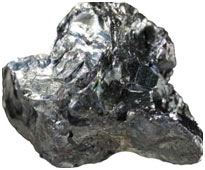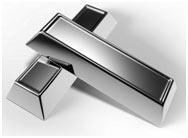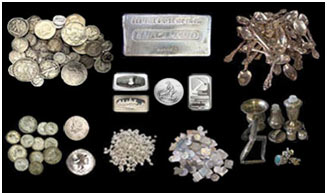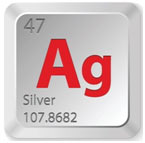Introduction
Silver is a precious metal present in group number 11 of the periodic table.
- Its atomic number is 47 whereas its atomic mass is 107.86.
- It has 47 electrons.
- Silver has 47 protons and 60 neutrons in its nucleus.
- Its scientific name is Argentum.
- Silver is represented by the symbol “Ag”.
Naming and History
The name silver is from the Anglo-Saxon word “Seolfor”. However, its scientific name “Argentum” is derived from the Latin word which means silver. It is in turn derived from the Sanskrit word “Argunas” which means shining.
Silver has been known to man since prehistoric times. Slag heaps in Anatolia in Turkey and Greece showed that silver mining is dated as long as 3000 B.C. The silver artifacts have been found in the Sumerian city.
People of that time obtained it through the process called cupellation; the method invented by the Chaldeans. First, the ore was smelted, then the cupellation of metals was done i.e., metals were heated up to 1000 C in a strong stream of air.
As a result, lead reacted with oxygen to form a lead oxide, leaving behind the liquid silver metal.
Silver is linked with money for a very long. In at least 14 languages such as in French word “Argent” is used for silver and the same for money. Similarly, Romans used the “Argentarius” word for silver, which they also used for the banker.
Occurrence of Silver

Silver is one of the rare elements on Earth’s crust. It can be found free as well as in combined form with other metals or elements. It can exist in crystal form but most commonly as compact mass.
The common ores and minerals containing silver are Argentite, tetrahedrite, galena, native silver, acanthite, etc. The deposits of silver are found in Mexico, China, Bolivia, Germany, Norway, and Canada.
Silver is also mined along with copper, zinc, lead, nickel, and gold.
Properties of Silver

Pure silver is white in color, soft, lustrous, ductile, and malleable. It is stable in oxygen and water but in air, it tarnishes due to the reaction of sulfur compounds which form a black layer. It mostly does not react as it is not chemically active but can be attacked by nitric and hot concentrated sulphuric acid.
It is the best conductor of electricity and has high conductivity among all metals. Silver is used as a standard to measure the conductivity of other metals. But due to its expensive cost, it is not generally used in wires.
The melting point of silver is 961.78°C and its boiling point is 2162°C. It has a density of 10.501 grams per cubic centimeter. It exists as solid at room temperature.
Silver in Biological Systems
Silver has no known significant biological role. Silver is considered to be non-toxic for humans. However, if ingested in large amounts can cause a condition called argyria turning skin color and mucous membranes greyish.
Silver compounds and their salts are poisonous and considered to have antiseptic properties. Silver can kill bacteria and other lower organisms efficiently.
Uses of Silver

- The main use of silver is as a precious metal “Sterling silver” (an alloy with 92% silver) in Jewelry, silverware, and other decorative products.
- It is used in making printed circuit boards with silver paints, high-quality electrical switches, and sometimes solders.
- It is an excellent reflector of visible light. This property makes it used in mirror coatings.
- Silver iodide is used in artificial rain cloud systems.
- Silver is used in manufacturing silver-zinc and silver-cadmium batteries.
- Silver is used as a catalyst in oxidation reactions.
- It is also used in making coins and other silver artifacts.
Isotopes of Silver
There are almost 35 known isotopes of silver whose mass number ranges from 94 to 128. Ag- 107 and Ag- 109 are two naturally occurring stable isotopes whose abundance is 51.8% and 48.2 % respectively.
MCQs about Silver Element
- Which element group does silver belong to in the periodic table?
- A) Group 10
- B) Group 11
- C) Group 12
- D) Group 13
- Answer: B) Group 11
- What is the atomic number of silver?
- A) 45
- B) 46
- C) 47
- D) 48
- Answer: C) 47
- What is the scientific name of silver?
- A) Silver
- B) Argentum
- C) Cuprum
- D) Ferrum
- Answer: B) Argentum
- When was silver mining known to have occurred as per archaeological evidence?
- A) 1000 B.C.
- B) 2000 B.C.
- C) 3000 B.C.
- D) 4000 B.C.
- Answer: C) 3000 B.C.
- How is silver commonly obtained from its ore according to historical methods?
- A) Distillation
- B) Cupellation
- C) Filtration
- D) Decantation
- Answer: B) Cupellation
- Where are some of the major deposits of silver found?
- A) India and Australia
- B) Mexico and China
- C) Brazil and Russia
- D) South Africa and United States
- Answer: B) Mexico and China
- What causes silver to tarnish when exposed to air?
- What is the primary use of sterling silver?
- A) Industrial machinery
- B) Electrical wires
- C) Jewelry and silverware
- D) Aerospace components
- Answer: C) Jewelry and silverware
- Which property of silver makes it useful in mirror coatings?
- A) High melting point
- B) Ductility
- C) Reflectivity
- D) Electrical conductivity
- Answer: C) Reflectivity
- What is the most abundant isotope of silver?
- A) Ag-107
- B) Ag-109
- C) Ag-110
- D) Ag-112
- Answer: A) Ag-107
- How many electrons does silver have?
- A) 45
- B) 46
- C) 47
- D) 48
- Answer: C) 47
- Which acid can attack silver?
- A) Hydrochloric acid
- B) Sulfuric acid
- C) Nitric acid
- D) Acetic acid
- Answer: C) Nitric acid
- What is the density of silver?
- A) 8.5 g/cm³
- B) 9.0 g/cm³
- C) 10.5 g/cm³
- D) 11.0 g/cm³
- Answer: C) 10.5 g/cm³
- Which language’s word for silver is also commonly used to mean money?
- A) English
- B) French
- C) German
- D) Spanish
- Answer: B) French
- In what form is silver commonly found in nature?
- A) Gas
- B) Liquid
- C) Solid
- D) Plasma
- Answer: C) Solid
- What is the boiling point of silver?
- A) 1500°C
- B) 1800°C
- C) 2000°C
- D) 2162°C
- Answer: D) 2162°C
- Which isotopes of silver are naturally occurring and stable?
- A) Ag-104 and Ag-108
- B) Ag-107 and Ag-109
- C) Ag-111 and Ag-113
- D) Ag-114 and Ag-116
- Answer: B) Ag-107 and Ag-109
- What is the symbol for silver?
- A) S
- B) Ag
- C) Si
- D) Sr
- Answer: B) Ag
- Which method was historically used to extract silver from its ore?
- A) Distillation
- B) Filtration
- C) Cupellation
- D) Sublimation
- Answer: C) Cupellation
- What condition can excessive ingestion of silver lead to, resulting in a change in skin color?
- A) Cyanosis
- B) Erythema
- C) Argyria
- D) Jaundice
- Answer: C) Argyria
- Which metal is often mined along with silver?
- A) Iron
- B) Aluminum
- C) Copper
- D) Titanium
- Answer: C) Copper
- What is the primary use of silver iodide?
- A) Food preservative
- B) Fertilizer
- C) Artificial rain cloud systems
- D) Medical disinfectant
- Answer: C) Artificial rain cloud systems
- What property of silver makes it suitable for use in electrical switches?
- A) Ductility
- B) High conductivity
- C) Reflectivity
- D) Low density
- Answer: B) High conductivity
- Which language’s word for silver is derived from the Latin word meaning silver?
- A) English
- B) French
- C) German
- D) Spanish
- Answer: D) Spanish
- What is the melting point of silver?
- A) 800°C
- B) 900°C
- C) 1000°C
- D) 961.78°C
- Answer: D) 961.78°C
Summary
In conclusion, silver is a valuable element with a rich history and diverse applications. From its early discovery dating back to prehistoric times to its modern uses in various industries, silver continues to play a significant role in our lives. Its occurrence in nature, distinctive properties such as high conductivity and reflectivity, along with its isotopic composition, contribute to its widespread utility.
Despite its toxicity in certain forms, silver compounds also possess antimicrobial properties, adding to its versatility. Whether in the form of jewelry, electronics, or even cloud seeding, silver remains a precious commodity with enduring importance in both historical and contemporary contexts.

